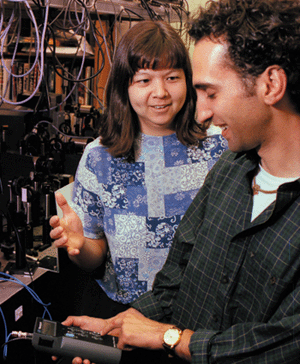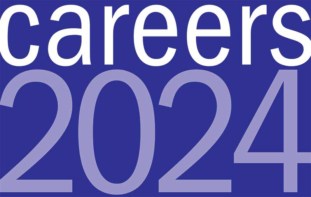With the first international conference on women in physics taking place in Paris this month, Valerie Jamieson discovers that the battle cry of the French Revolution – liberty, equality and fraternity – is just as relevant in physics today as it was in France over 200 years ago

When the astronomer Jocelyn Bell Burnell was in her final year as a physics student at Glasgow University in the early 1960s, she was greeted by a barrage of wolf whistles and foot stamping every time she walked into a lecture theatre. The reason for all this unwanted attention was that Bell Burnell was the only woman in an honours class of 50 undergraduates.
Thankfully, this is a tale that few young female physicists today would recognize. But even though the number of women studying physics has increased over the past 40 years, they still remain seriously under-represented. In Japan, for example, just 13% of physics undergraduates are women, while fewer than one in five physics degrees in the US are awarded to women.
The imbalance between the sexes becomes even more pronounced higher up the career ladder. Women occupy just 3% of the permanent physics positions in the Netherlands, for instance, and there is just one female professor of physics in Denmark. “The low percentage of women is a real problem for physics because it discourages some possible talent from even considering a career in the field,” says Helen Quinn, vice-president of the American Physical Society and a theoretical physicist at the Stanford Linear Accelerator Center in California.
The low numbers of women in physics will be one of the underlying themes at the conference on women in physics being organized by the International Union of Pure and Applied Physics (IUPAP) in Paris this month. The conference is expected to attract 300 delegates and will discuss six main topics, including “attracting girls into physics”, “balancing family and career”, and “getting women into the physics power structure”.
At the end of the Paris meeting, delegates will publish a list of resolutions that will be sent to physical societies, funding agencies and governments throughout the world. The 65 national delegations present in Paris will also follow up the recommendations when they return home.
Marcia Barbosa, chair of the IUPAP women in physics working group, believes in change coming from the bottom up – from the scientists in the universities to the physical societies and funding agencies. “When governments people fighting for change, they will have to act,” says Barbosa, who is a statistical physicist at the Universidade Federal do Rio Grande do Sul in Brazil.
Early advantages turn sour
Being one of only few women in physics can have its advantages. Like many women, Helen Quinn believes that it made her more noticeable and memorable early in her career. Ursula Keller, a laser physicist at the ETH in Zurich, agrees: “When you are young and showing result after result, people are so happy that they have found a woman who is good and they are very supportive. Men act like a big brother or a father figure.”
But Keller encountered harder times as she climbed the career ladder. “If you have the competitive edge, some men have a difficult time accepting that you are better than them,” she warns. “The older I got, the more I found being a woman a handicap.”
Margaret Murnane, a laser physicist at the JILA laboratory in Boulder, Colorado, has had similar experiences. “I am better remembered because I am a woman, which is good, but 10% or 20% of male physicists are uncomfortable or threatened by the idea of female physicists, in the US at least. They have made life very, very difficult for me in the past – until I learned to go around them.”
Such bias against women can be difficult to identify and quantify. However, three years ago an influential study of the status of women at the Massachusetts Institute of Technology (MIT) came to the same conclusion: “The committee discovered that junior women faculty [in the school of science] feel well supported within their departments and most do not believe that gender bias will impact their careers. Junior women faculty believe, however, that family-work conflicts may impact their careers differently from those of their male colleagues. In contrast to junior women, many tenured women faculty feel marginalized and excluded from a significant role in their departments. Marginalization increases as women progress through their careers at MIT. Examination of data revealed that marginalization was often accompanied by differences in salary, space, awards, resources and response to outside offers between men and women faculty with women receiving less despite professional accomplishments equal to those of their male colleagues. An important finding was that this problem repeats itself in successive generations of women faculty.”
Keller believes that the situation will only change when more women hold senior positions. Until that happens, however, she copes by being successful and true to herself. “I am not going to change to fit men’s expectation of women,” she insists. “If I become too depressed or angry – and sometimes I do get angry – then I’ll only be less effective in my job.”
Deborah Jin, an atomic physicist at JILA, finds that it is easy to recognize blatant sexist comments and dismiss them. More often, however, the discrimination she encounters takes a more subtle form. “Many people have an unintentional inclination to take a female physicist less seriously,” she says. “Perhaps this arises simply from the observation that more physicists are men.”
Examples of subtle forms of discrimination include male colleagues addressing female physicists as Mrs, rather than Dr or Professor, or mistaking them for the group secretary. However, when asked if they think physics is too macho, opinions among women differ (see below).
| Is physics too macho? |
| “Physics exists in the abstract and is genderless, but the people who do physics might be too macho. Actually, being too macho, though it might often work to your advantage, can also be a liability when it prevents you from acknowledging what you don’t know.” Lisa Randall, Harvard University, US |
| “I could never think physics is too macho – maybe physicists are too macho.” Gisela Anton, Erlangen University, Germany |
| “Yes, sometimes there is a very aggressive and unsupportive attitude in UK academia. This is particularly prevalent in maths and physics.” Helen Mason, Cambridge University, UK |
| “YES. YES. YES.” Margaret Murnane, JILA, US |
Affirmative action in Paris
Last year the IUPAP women in physics group began an international benchmarking study to understand the demographics of physics and the experiences of female physicists in 65 different countries. Roman Czjuko and colleagues at the American Institute of Physics are currently analysing the results, which will be presented at the Paris conference. “This survey is unique in that it will be the only international survey about women in physics in my lifetime,” says Czjuko. “Such studies are challenging because it is notoriously difficult to compare countries with different education systems, cultural backgrounds and economies.”
The survey will look at the latest statistics on education and gender collected by national agencies in 15 countries, as well as anecdotal evidence gathered by working groups in another 20 countries. Another part of the study is a Web-based questionnaire that asks women about their personal experiences throughout their career and also about family issues. So far over 900 women from 50 countries have responded. “We are looking for critical moments that have either helped or hindered a woman’s career,” explains Czjuko. “And from them, we hope to find interesting themes that could form the basis of action plans.”
Barbosa is worried by the fact that many countries deny that the problems faced by female physicists exist. In Latin American countries, for example, women hold about 20% of the faculty positions. “That’s a huge number in comparison with other countries,” says Barbosa, “so many women do not think there is a problem. But as you look along the career path, you see very few women at higher levels, or holding grants or positions of power. Something has to change. Women have to realize that they have to fight for change.”
Fixing the leaky pipeline
The problem of the low numbers of girls opting to study physics at school and university is compounded by the fact that a higher proportion of women than men tend to leave physics at each stage on the career ladder. Several countries have recently introduced women-only university positions and grants to counter the effect of this “leaky pipeline” (see The ladies vanish, p36 print version of Physics World only). The French government has also established a “mission for parity” to ensure that female researchers are treated fairly (see Cherchez la femme, p33 print version of Physics World only).
However, Catherine Cesarsky, director general of the European Southern Observatory, has mixed feelings about such schemes. Cesarsky believes that many women lack self-confidence – something that stems from their education and experiences when they were younger. “That’s their biggest problem because they are certainly as smart as the men,” she says. “I worry that giving women special privileges will undermine their self-confidence and may also put them at a disadvantage because some people will say that ‘she only got the job or prize because she is a woman’.”
Alice White, director of photonics at Bell Labs, the research arm of Lucent Technologies, agrees that it benefits no-one to promote a woman who is not capable, but adds that it is more difficult for women to advance in their careers. “The barrier for women to get over is higher than it is for men,” she argues, “and until it is at the same height then we have to be proactive. We have to make sure that people have a chance to prove themselves.”
As a postgraduate student, White had a Bell Labs fellowship that was designed to encourage women and minorities into science. These days, she remains active in these programmes and also in the recruitment of women. And with her husband, who is also a physicist, White gives science demonstrations to children at her daughters’ school because she finds that most of the female teachers in primary schools are uncomfortable with teaching maths and science. It is also important, says White, to show young children that women actually do science (see Learning lessons from the classroom and How to harness girl power, p34 print version of Physics World only).
Lisa Randall of Harvard University also benefited from a Bell Labs scheme as a graduate student. “This freed me from other responsibilities I would have had as a graduate student so I could focus on research,” she recalls. “Although such programmes can be controversial, I think this was a great one.” Since then Randall has gone on to a highly successful career in theoretical particle physics, and two of her articles are currently the “hottest” papers in physics according to citation analysis.
Anne L’Huillier, a laser physicist at Lund University in Sweden, has also benefited from a Swedish scheme to increase the number of female science professors. Nonetheless, just two of the 40 physics professors at Lund are women. L’Huillier believes that more female professors are needed as role models to encourage a greater number of young women to pursue physics as a career.
Changing attitudes
Parents have been a key influence in the career choices of many successful female physicists. Deborah Jin’s father is a physics professor and her mother has a masters degree in engineering physics and worked as an optical engineer. “I admired the fact that my dad, like most physicists, really enjoyed what he did,” she says, “and I was always proud of the fact that my mum worked as an engineer in a company that employed most of the other kids’ dads.”
While her family ties with physics explain why she started studying the subject, Jin has stayed in physics because she had positive experiences working in labs as a student during the summer holidays.

Others have not found it so easy. Margaret Murnane admits that she has been on the verge of giving up physics many times in the past, partly because a small number of men have made life difficult for her. “Physics is dominated by a male idea of how to do things and how to interact,” she says. “It is unbalanced. Men and women are equally good at the scientific process, but their style is often different. There is nothing wrong with that.” Murnane should know – she and her husband are joint leaders of one of world’s leading laser research groups.
Bell Burnell, who is now dean of science at Bath University in the UK, believes that while some women can readily cope with the male ethos, others change their behaviour in order to cope – but often at great personal cost.
Indeed, Catherine Cesarsky believes that life would be better for men and women if there was better balance between the sexes. “Because people in our profession work such long hours, it is much better to be with people of both sexes,” she says. “Everything is immediately more comfortable if both sexes are present.”
The situation seems to be somewhat better for women working in industry, and more women are starting to reach the top positions in Fortune 500 companies like Xerox, Hewlett Packard and Lucent Technologies. Alice White says that getting the job done is what matters in industry and that results, not gender, speak volumes. She also believes that the hierarchical management structure in companies means that women in industry are seeing change faster than their academic counterparts. “A change in attitude at the top soon filters down,” she explains, “but in universities, professors often form their own little empires and there are deep pockets of resistance to change.”
White admits that one of her role models is Cherry Murray, senior vice president at Bell Labs (see The industrial physicist who has it all, Physics World May 2001 p9). She admires Murray for her work as a scientist, for her management style, and for her ability to juggle both family and career successfully. “Her abilities and the standards she sets herself soon dispelled any notion that she got her job because she is a woman,” says White.
While role models have not played a major part in the career choices of most of the women Physics World spoke to – parents have been a much bigger influence – this generation of established female physicists is providing role models for a new generation of female physicists. Kate Adamson, a PhD student in particle theory at Durham University in the UK, says that she has a tremendous amount of respect for the women who have become professors of physics: “You can see that they have fought and fought, and they are still fighting.”
Balancing family and career
So why do so many women drop out of physics after their PhD or a stint as a post-doc? Anne L’Huillier has experienced life as a physicist in both France and Sweden. “The system is much harder in Sweden because you tend to get a permanent job in your late 30s, rather than your early 30s,” she explains. “Perhaps young women – even those who are not thinking about children – see how hard people have to work and decide against it.”
Many young women with husbands who are physicists leave physics altogether due to the difficulty of finding two permanent jobs in the same place. Often these women regard their partners’ career more important than their own and are willing to forsake their own research (see Love and the two-body problem, Physics World October 2001 pp37-39).
But clearly the biggest difference between men and women is children, and many female physicists feel that their career has suffered as a result of taking a break. Helen Quinn believes that the limitations in her career advancement have come more from the choices she has made for family reasons, rather than from prejudice against her as a female physicist.
Helen Mason, an astrophysicist at Cambridge University, has opted to worked part-time most of her career in order to bring up her two children. This has meant that she still has to rely on short-term contracts. “Part-time work is not accepted in the UK and my career has suffered seriously,” she complains. “I now earn much less than my male colleagues do. Most of my peers are professors. I believe that I am just as able as them. I could, and I do, get angry about this.”
But Ursula Keller – who has two children aged five and three – believes that women should wait until they are established in their careers before having children. “You can’t work part-time and then say you want to be a professor,” she explains, “because people won’t think you are serious. There are some phases in your career when having kids is a dumb idea.” Keller says she has seen younger women with families who are not even given a chance. “It is very subtle – they are not given the most prestigious projects and they get sidelined.”
Keller also wants to see an environment where women can readily combine children and a career. “Having a child changed my life more than anything else,” she says, “but a lot of the benefits offered to women are superficial.” She stresses that it is crucial for women in academia to concentrate on their research. Keller would like to see employers take an imaginative and flexible approach to women who have just had children, offering them partial relief from teaching or administrative duties for long periods of time, rather than full maternity leave for several months.
But L’Huillier believes that such a scheme – although great for women – would simply be unworkable: “You have to be aware and accept that your career will not move forward as fast if you have children – it is up to individual women to decide how long this period lasts.” She adds that physics is a fun job where women are free to adjust their time to suit their families.
White, however, believes that it is a “myth” that in order to be a really good physicist, women have to do physics to the exclusion of everything else, including their family. “I think that this myth will die as more and more men share the parenting responsibility with their working wives,” she adds.
Yet many successful women have managed to achieve a balance between family and working life. “It is totally possible,” says Keller, “but it relies on the choices you make.” She sees many women in Germany and Switzerland “beating themselves up” because they spend so little time with their families, but she believes that women should not feel so guilty.
It is a view that Catherine Cesarsky – who has two children – shares: “It is another pitfall that, by some miracle, I avoided.” Keller adds: “In physics you are much more in control of your time and have much more flexibility than women in many other jobs.” However, she does have one unusual piece of advice: “Don’t have kids before you have a professorship.”
Tips for women
So what advice do these successful women have for aspiring physicists? Deborah Jin believes that is important to realize that physics is challenging and that it is easy to get discouraged. Women, in particular, should strive to remain confident about themselves and in their abilities.
Alice White agrees. “Stick with it,” she urges, “the intellectual stimulation you get in the physics community will help you learn and grow your whole life.” It is also important, believes Margaret Murnane, for women to understand that some of the negative aspects they encounter are not personal.
“Stand up and speak out” is the advice from Hide Fukuyama, director of the Institute for Solid State Physics at the University of Tokyo. Fukuyama believes that women need to take the lead, “even in tiny things like organizing seminars and parties”. She believes that it would be good to systematically encourage such behaviour in women, though it would be “somewhat against the tradition in Japan”.
To be successful, claims Helen Quinn, women have to recognize that they must be both capable and assertive without becoming aggressive or defensive. “You need to know how to stand your ground in a physics argument,” she says, “and to accept questions as interest, rather than as a challenge to your work.”
The role of men
While women are leading the battle for equality, men have an important role to play as well. Cesarsky finds that, in general, men become really interested in these issues when they themselves have intelligent daughters and suddenly realize the problems that their children will encounter.
Alice White at Bell Labs also believes that it is crucial to get support from men. She recalls the time she was at an international physics conference when the keynote speaker – a well-known physicist – began telling offensive sexist jokes to the largely male audience. Afterwards, one of White’s colleagues – another senior male physicist – took the speaker to one side and scolded him for his insensitivity. “That really got his attention,” says White. “The moral of the story – women can’t do it alone.”



